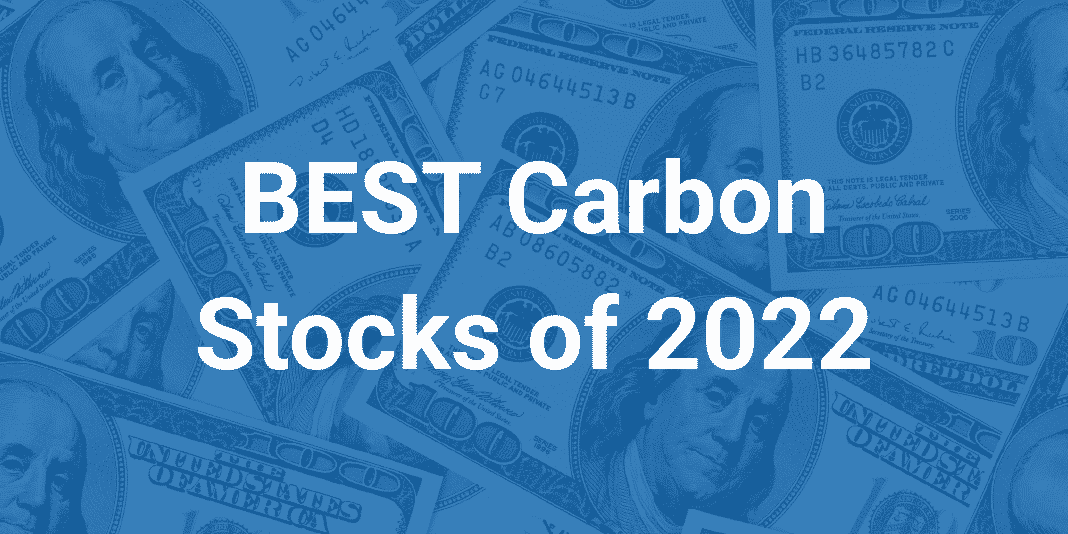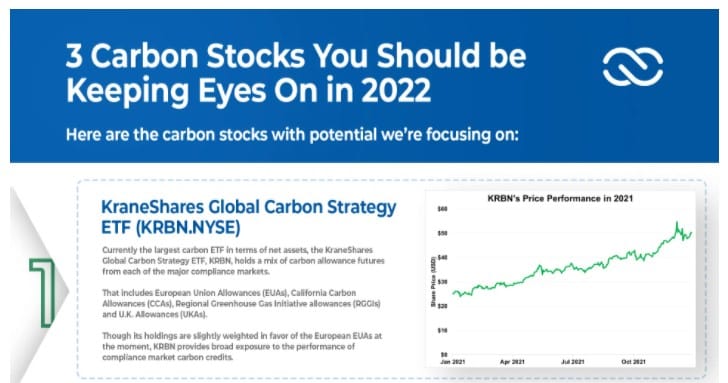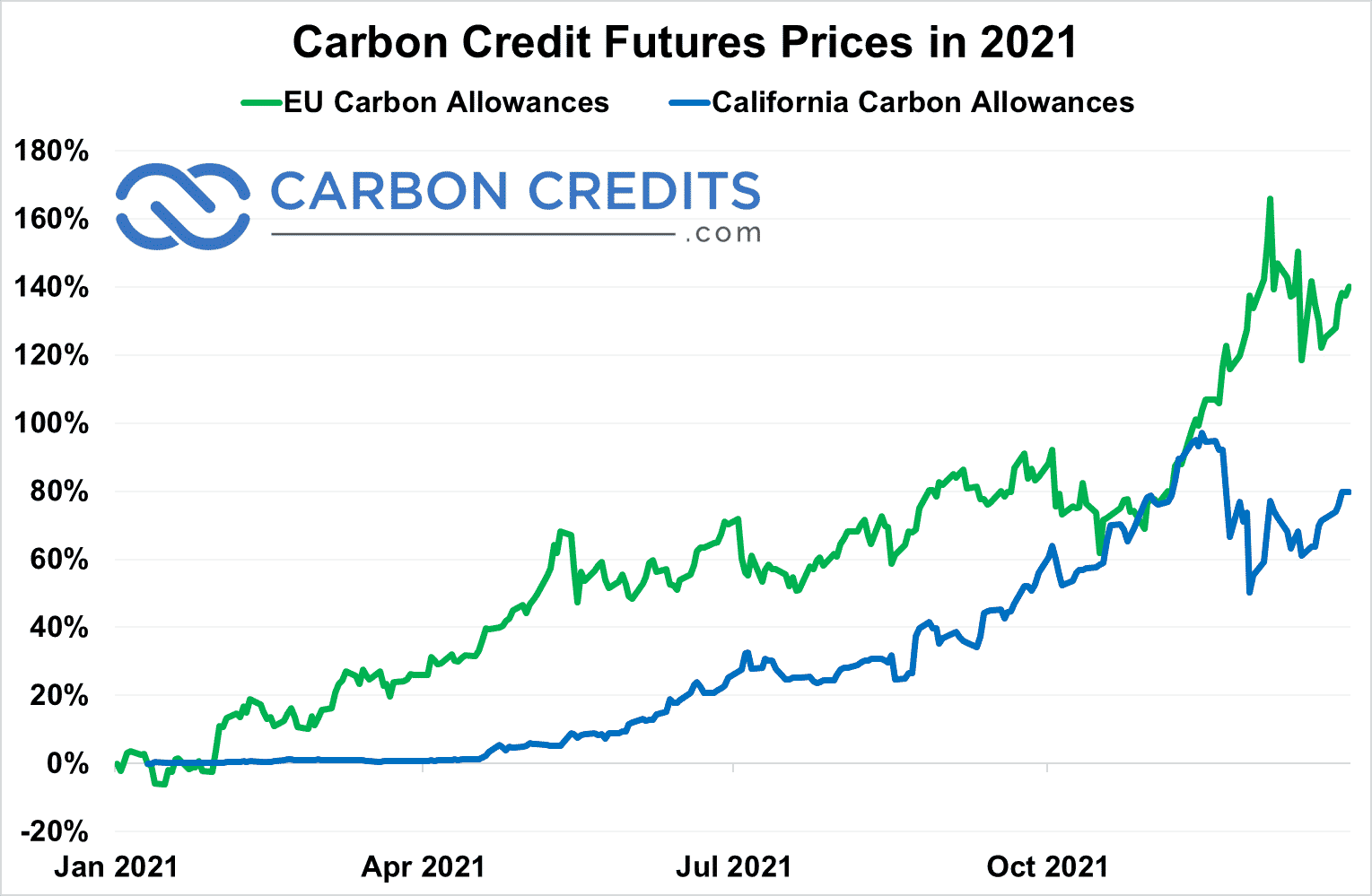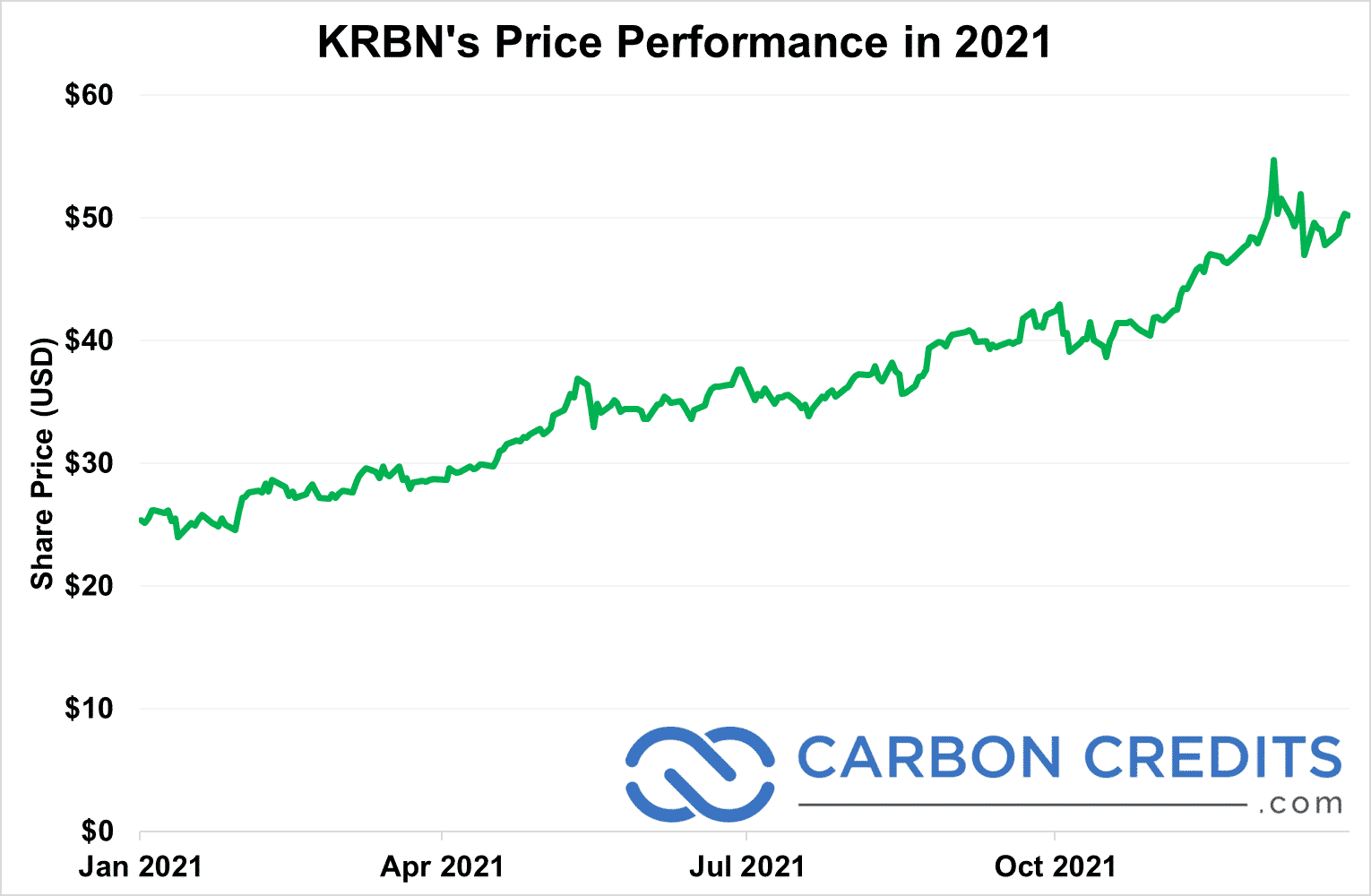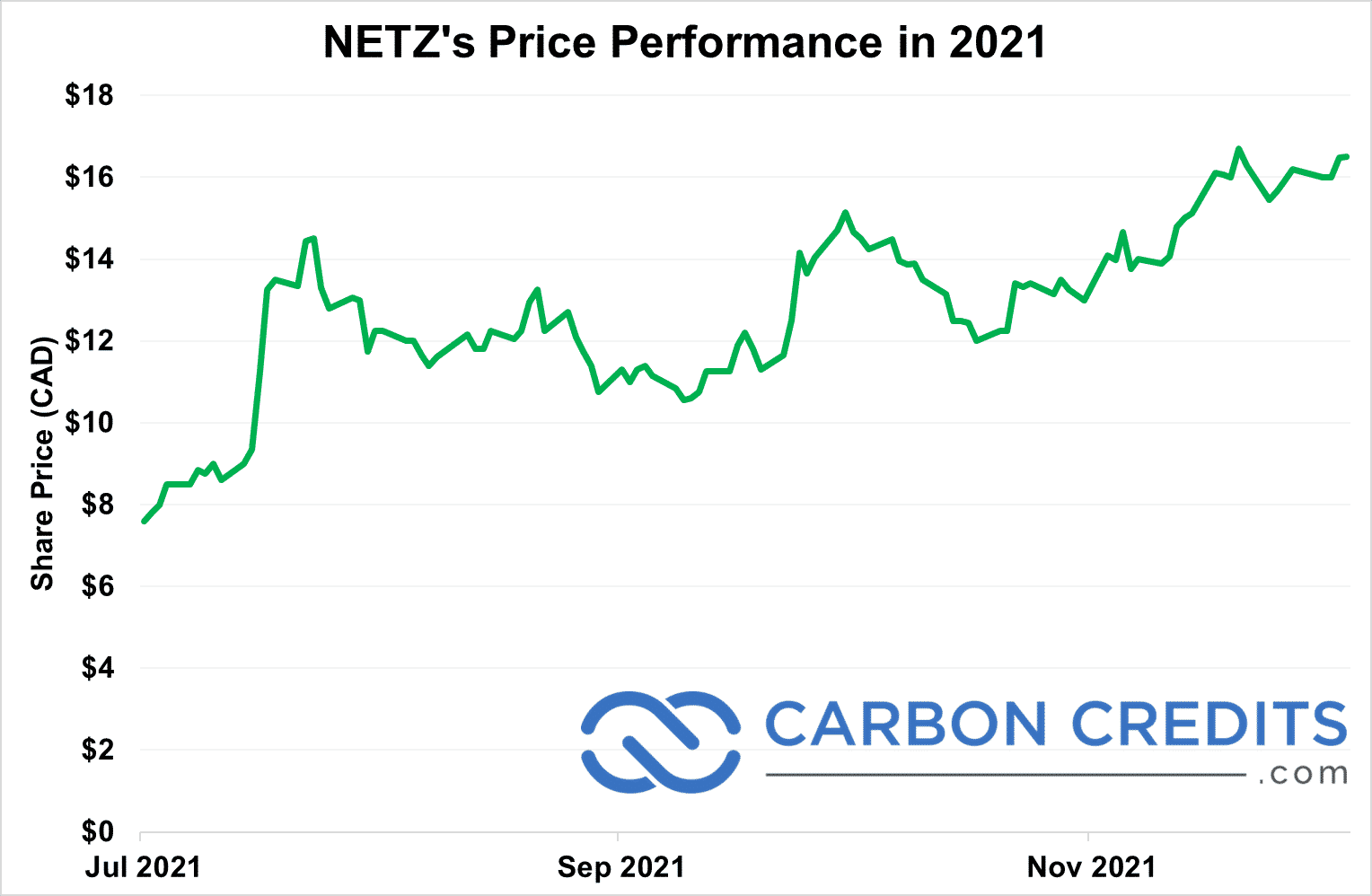Key Points:
- These “carbon stocks” are doing their part to achieve a net-zero world. And catching investors’ attention.
- KRBN, NETZ, OFSTF and BEP are stocks in focus in rising carbon markets.
An infographic version of this post can be found here or by clicking the image below.
As most of you are probably aware, 2021 was a banner year for carbon investments around the world.
And 2022 is setting up to attract a lot of investor attention in the carbon markets. Especially as it relates to carbon stocks.
Carbon prices went on a tear in the wake of rising awareness of the dangers of climate change thanks to the many extreme weather events that took place last year.
Not to mention other events like the highly publicized COP26 United Nations climate change conference in Glasgow.
Future Carbon Prices
By the end of the year, European carbon allowances were up over 150%. Their Californian equivalents saw a more modest, but still impressive, 80% gain:
While these were impressive performances that might make you think you’ve already missed the boat, nothing could be further from the truth.
Carbon Markets Set to Soar In 2022
The carbon markets are still in their infancy and will need to see continued growth if the world is to meet the climate change target set out during the Paris Agreement.
This is the international accord to limit global warming to below 2 degrees Celsius, signed and ratified by all but four countries in the world.
Though the rough framework for a fully regulated global carbon market has already been laid out by the Article 6 agreement at COP26 last year, it could still be years before such a market actually comes into existence.
And when it does, it’s uncertain how it’ll interact with the current compliance and voluntary carbon markets. Will it merge with currently existing marketplaces or exist alongside them?
That’s why it’s the Wild West in the carbon markets right now. There are tons of unexplored territory with very little oversight. But opportunities abound, and there’s plenty of money to be made if you look in the right places.
So that brings us to the most important question of them all: where should we be investing right now?
3 Carbon Stocks You Should be Keeping Eyes On in 2022
Here are the carbon stocks with potential we’re focusing on:
KraneShares Global Carbon Strategy ETF (KRBN.NYSE)
Currently the largest carbon ETF in terms of net assets, the KraneShares Global Carbon Strategy ETF, KRBN, holds a mix of carbon allowance futures from each of the major compliance markets.
That includes European Union Allowances (EUAs), California Carbon Allowances (CCAs), Regional Greenhouse Gas Initiative allowances (RGGIs) and U.K. Allowances (UKAs).
Though its holdings are slightly weighted in favor of the European EUAs at the moment, KRBN provides broad exposure to the performance of compliance market carbon credits.
These are currently one of the best ways for not only retail investors, but also corporations, banks and other financial institutions to invest in the carbon markets.
By matching the price performance of these compliance market carbon credits through its holdings, KRBN allows the average investor to add exposure to carbon prices to their portfolio without having to purchase futures, which are complicated and risky to invest in.
Investors who held KRBN at the beginning of 2021 would’ve seen their investment more than double by the end of the year, mimicking the price performance of European and Californian carbon credits.
Those of you who think carbon allowance prices are going to continue their strong performance in 2022 will definitely want to keep KRBN on your watchlists.
- Click here to learn more about KRBN.
Carbon Streaming Corporation (NETZ.NEO and OFSTF.OTC)
As the carbon markets are still in their early stages, so too are the investment opportunities – most of the listed entities you’ll find are exchange-traded products of some sort.
Index funds and ETFs do an excellent job of tracking their underlying assets. However, those who are both able and willing to stomach greater risk will also see greater potential for return on their investments.
- NETZ is just one such opportunity. It trades in Canada on the NEO exchange and in the U.S. markets under the symbol OFSTF for now.
The company has secured an early-mover advantage by not just being the first streaming/royalty deal in the carbon credit space, but also by being among the first carbon-credit-focused businesses to go public.
For those of you who aren’t in the know, the streaming/royalty business model is an extremely lucrative one whose roots lie outside of the financial markets.
Here’s how they work:
- Find an asset with upside and pay an upfront fee
- Get a share of the future output for set period of time
Music royalties, for example, are one of the oldest and most well-known examples. Artists can sell their catalog and rights upfront for $, the owners of the ‘royalties’ get a share in the profits in the future.
In the 1980’s Michael Jackson thought the Beatles catalog had upside paid over $50 million to secure the rights in the future (actually outbidding the actual Beatles).
Those assets grew over time and the value of the overall catalog grew alongside it.
The business model has since made its way into many different types of commodities, with gold and precious metals streaming and royalty companies being another prominent example.
And just like how Sony bought up the Beatles music catalog at a $1.5 billion valuation in 2016. NETZ is betting big to lock in agreements with some of the highest-quality carbon credit projects out there.
- These include the Rimba Raya Biodiversity Project in Indonesia, one of the world’s largest REDD+ projects that’s expected to offset 130 million tonnes of CO2e over the next 30 years.
Those of you with a higher risk tolerance for your investment portfolios will want to check out NETZ. Its business model, in addition to it being the first of its kind in the carbon markets, could potentially allow NETZ to outperform relative to the rest of the carbon credit market.
- Click here to learn more about NETZ.
Brookfield Renewable Partners (BEP.NYSE)
It should be clear to everyone at this point that the surge of interest and capital into green investing isn’t going away anytime soon.
However, if you’re still not totally sold on the idea of carbon credits or have a lower appetite for risk in your portfolio, there are more conservative ways to play the green investment boom.
One such example would be with a company like BEP which trades on the NYSE. It’s one of the largest pure-play renewable energy companies in the world.
BEP has extremely diversified holdings, with nearly $60 billion in power assets located in over a dozen countries across four continents, split across hydro, wind, solar and energy transition projects.
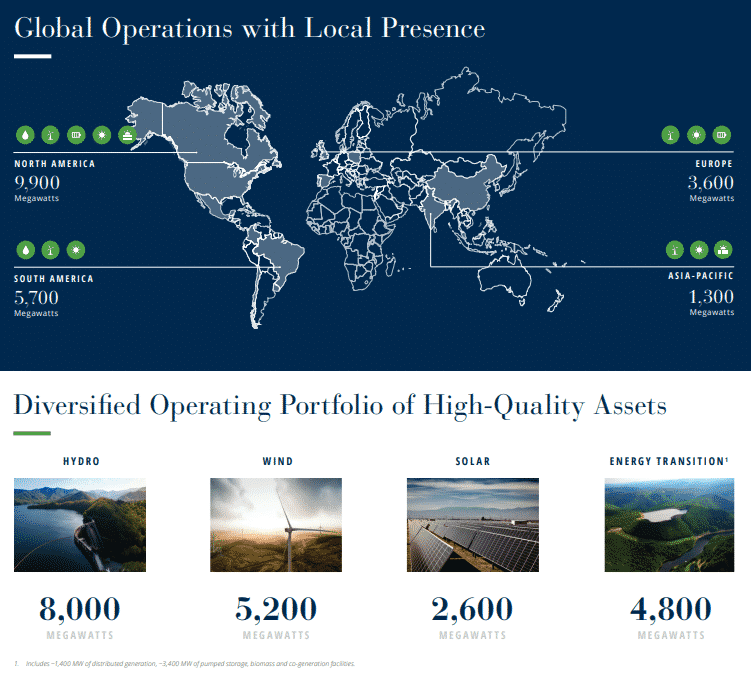
The company has managed consistent growth over the past decade, with distributions to unitholders growing at an average annual rate of 6%. They have a strong balance sheet with a healthy capital pool, and no need to go back to the markets for equity.
In other words, BEP is an extremely well-run clean energy company with a great business model and a long history of solid performance – all before carbon credits even enter the picture.
To be fair, BEP is likely not a company that will benefit significantly from the growth of the carbon credit marketplace. Renewable energy projects are generally considered “low-quality” carbon credit projects due to their lack of additionality.
Simply put, many renewable energy projects are already profitable even before taking carbon credits into account. This makes any credits they could generate less worthwhile, because many of these projects would have happened even without the presence of carbon credits.
With all that said, as previously mentioned, BEP was already a great company even before carbon credits came along; the coming wave of decarbonization can maybe help lift it higher.
So, if you would still like a little bit of exposure to the carbon market in your portfolio, but you’re not very gung-ho about the future of carbon credits or would prefer a lower risk play, BEP is one company you might want to keep your radar.
- Click here to learn more about BEP.
The Best Carbon Stocks Should Generate a Lot of Interest from Investors
With a large number of public companies declaring their Net-Zero ambitions and disclosing carbon emissions, socially responsible investing is becoming a major theme in financial markets. There are trillions of dollars of investment going into renewable energy and the offsetting emissions.
Facebook (Now Meta Platforms), Apple and Netflix are among the major tech companies leading this charge to net-zero targets for 2030. And major mining (Barrick, Newmont) and energy companies (Exxon, Shell) are doing the same.
These factors will drive increasing investor interest in all things carbon related in 2022 and beyond. Expect things to accelerate as net zero targets for 2030 draw closer.
Rising tides can lift all boats, and the best carbon stocks should generate some of the best returns for investors. These carbon companies have shown themselves to be steady value drivers with the financial acumen to capture many opportunities for solid returns in the past, and should be on the top of any green investor’s watchlist for 2022.
Disclosure: Owners, members, directors and employees of carboncredits.com have/may have stock or option position in any of the companies mentioned: NETZ, BEP
Carboncredits.com receives compensation for this publication and has a business relationship with any company whose stock(s) is/are mentioned in this article: NO
Additional disclosure: This communication serves the sole purpose of adding value to the research process and is for information only. Please do your own due diligence. Every investment in securities mentioned in publications of carboncredits.com involve risks which could lead to a total loss of the invested capital.
Please read our Full RISKS and DISCLOSURE here.

